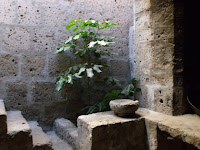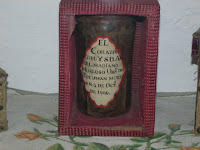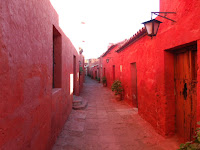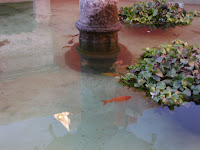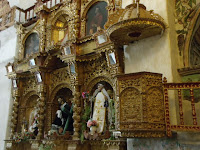 |
| Ornaments on this year's tree. |
Friday, December 9, 2011
Monday, November 7, 2011
La Tarumba!
Near the very end of our stay in Lima Willy, Elba, Toya, and Orlando invited us to the La Tarumba circus show in the southern district of Chorrillos.
La Tarumba is a locally developed circus that seeks -and manages- to combine circus with music, song, and dance. Among its directors and performers, for example, they count Amador "Chebo" Ballumbrosio, of the famous musical family from the city of El Carmen. Ballumbrosio, son of his much-admired namesake, brings an Afro-Peruvian musical sensitivity and rythm to La Tarumba.
La Tarumba started in the 1980s as street performers. In the early 1990s they managed to establish an HQ in a house in Miraflores, and in 2003 they were able to purchase their tent. According to their website they felt at then that they were finally "a real circus", and committed themselves to putting on a show a year, every year.
So far, they've kept their word.
This year's installment was Quijote, based, of course, on the story of Don Quixote de la Mancha written by Miguel de Cervantes. It is a story that is well-known in Latin America, Cervantes holding a similar place in Spanish-language literature as Shakespeare does in English. Moreover, Quijote's tenacity of struggle against all odds and his daring to dream of a better world resonate with Latin American's own history of struggle.
 |
| The windmill scene |
La Tarumba did a wonderful job at creatively bringing the elements of the story to life in the circus ring
 |
| Don Quijote |
By the end, the audience was visibly moved by the show and Quijote's longing for love and a better world. It really was quite moving and sad, but La Tarumba was not about to let people leave on a down note: Ballumbrosio led the musical ensemble in a rousing number drawn from traditional Afro-Peruvian music celebrating the harvest and celebrating life.
This was my second time attending a La Tarumba show, as I had also gone with Willy and Elba during last year's season. I loved the show each time. I do have a hard time, however, deciding whether first place in the audience's hearts is taken by Ballumbrosio and the musical ensemble, or by La Tarumba's troupe of trained horses.
Sunday, October 16, 2011
Convent of Santa Catalina de Siena de Arequipa
One of the main attractions in Arequipa is the old Convent of Santa Catalina de Siena. Santa Catalina was built in the 16th century to accomodate the desire of the townsfolk of Arequipa for a convent in their city. Informed of thi wish during a visit, Viceroy Toledo, granted the necessary licenses for the establishment of a Dominican convent. A few years later, a young widow, Maria de Guzman, decided to take the vows and enter the nunnery, and in 1580 the convent was formally inaugurated and Maria named "the first inhabitant and prioress of said Monastery."
 For four centuries, Santa Catalina was community closed off from the rest of the world, enveloped in a mantle of silence and mystery, which contributed to both idealized imagining of life behind its walls and to lurid rumours. Pehaps each had some measure of truth. Santa Catalina, it is true, was a female-run world that lived by its own rules, laws and customs, dedicated to prayer and religious duty. On the other hand, many of the nuns came from wealthy families and sought to preserve their status and comforts within the convent's walls, bringing servants with them, building -or buying- large personal "cells" with sitting rooms, private kitchens, and running water, and continuing to wear jewelry and gold. One prioress, who tried to curb these practices, was the object of three separate poisoning attempts during her tenure!
For four centuries, Santa Catalina was community closed off from the rest of the world, enveloped in a mantle of silence and mystery, which contributed to both idealized imagining of life behind its walls and to lurid rumours. Pehaps each had some measure of truth. Santa Catalina, it is true, was a female-run world that lived by its own rules, laws and customs, dedicated to prayer and religious duty. On the other hand, many of the nuns came from wealthy families and sought to preserve their status and comforts within the convent's walls, bringing servants with them, building -or buying- large personal "cells" with sitting rooms, private kitchens, and running water, and continuing to wear jewelry and gold. One prioress, who tried to curb these practices, was the object of three separate poisoning attempts during her tenure!At its peak the convent housed some 400 women, about 180 of them being nuns, and the rest servants, slaves, young women boarded there for their education, and women who had been given asylum by the order. In the 1870s by order of the Pope, the servants and slaves were released, being given the choice of remaining and taking religious vows, or leaving the convent altogether.
Several dozen Dominican nuns still occupy a closed portion of the convent. However, earthquake damage in the 1960s led the nuns to construct new quarters at the north end of the convent, fitted now with electricity and running water -in accordance with municipal regulations- and the majority of the convent was largely restored to what it looked like in days past (although most of the upper stories and roof accesses are now long gone) and opened to public tours in 1970.
I have to honestly say that the convent was one of the more memorable places we visited. It is utterly fascinating to imagine the world that its walls must have encompassed, one little changed in the course of the centuries. A veritable city within the city, the 5 acre convent has streets,
plazas, fountains, a cemetery, and districts as any town would, as well as a hospital ward, a
laundry, and a communal kitchen. The frequent need for repairs has made
Santa Catalina a veritable catalogue of Arequipeno architectural styles
through time. I think we took more pictures there than at any other single site
Labels:
Antiquities,
Architecture,
Arequipa,
Historic Sites,
Monuments,
Museum,
Sierra
Tuesday, October 4, 2011
Colca 5: Santa Ana de Maca
On the way back to Arequipa from Cabanaconde and Cruz del Condor on July 30th, our driver had us stop at the town of Santa Ana de Maca, whose main attractions are a small church and photo opportunities offered by enterprising locals.
 The church was built in the 1600s, out of sillar, the white volcanic
stone that is characteristic of the region's architecture. It was
rebuilt after it was partially destroyed by a fire in 1759.
The church was built in the 1600s, out of sillar, the white volcanic
stone that is characteristic of the region's architecture. It was
rebuilt after it was partially destroyed by a fire in 1759.
Maca, located at 3262 meters (10,702 feet) above sea level, is a small town at the foot of Sabancaya volcano. In 1609 it was made the seat of the colonial bishopric of the region. Today the town lives from farming and a small share of the tourist economy.
 The church was built in the 1600s, out of sillar, the white volcanic
stone that is characteristic of the region's architecture. It was
rebuilt after it was partially destroyed by a fire in 1759.
The church was built in the 1600s, out of sillar, the white volcanic
stone that is characteristic of the region's architecture. It was
rebuilt after it was partially destroyed by a fire in 1759.
When we arrived there was a mass going on, and although we were not prohibited from entering, I hung back by the entrance for a bit. I was able to catch enough of the mass to realize that it was a misa de cuerpo ausente, a funerary mass marking an anniversary -likely one month- of someone's death. I chose then to exit and return later.
Outside, however, I was annoyed at a gaggle of European tourists who hung about snapping pictures of the parishioners and mourners as they left, particularly of the women dressed in the colorful traditional attire. I did realize that they had no idea of the solemnity of the occasion, nor were they dissuaded by their own guide, but it still bugged me.
The inside of the church itself is relatively ornate in contrast to the outside, but still less so than so many other baroque churches in Peru. It reflected a small town's best attempts, and evoked a prosperity long gone.
On each side of the nave there were effigies of saints, including a saint (Santa Ana?) in local attire and a 17th Century life-sized Christ the Nazarene. There are also paintings of the Cusqueno school and plenty of gold leaf.
To the left of the altar, in a side nave, there were stored the andas, or litters, upon which the effigies are carried in procession through the town on their holy days. Also kept there was rather detailed, life-sized effigy of the dead Jesus in a glass coffin, no doubt for the Easter Friday procession.
Being at the foot of the volcano and near a geological fault that transects the valley, the church of Maca has suffered damage throughout the centuries. Fortunately it was declared a national treasure in 1980 and has been restored and maintained through funding provided by the Spanish crown.
Next to the church a couple of locals had trained eagles to stand upon tourists' arms, knees, shoulders, or heads. He requested a donation for letting one take pictures with the birds, and no doubt garnered far more that way than if he had requested a set amount.
The birds themselves were quite handsome and surprisingly heavy, as well as patient.
After a few minutes of this we reboarded the bus and continued our way back to Arequipa.
Labels:
Antiquities,
Arequipa,
Barranco,
Fauna,
Historic Sites,
Road Travel,
Sierra
Subscribe to:
Comments (Atom)






